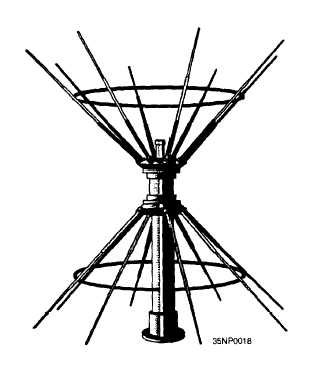.
Figure 2-25.—AS-2802/SCR discage antenna.
possible and away from any obstructions. The reason
for the high installation is that vertical conductors,
such as masts, rigging, and cables in the vicinity, cause
unwanted directivity in the radiation pattern.
For best results in the vhf and uhf ranges, both
transmitting and receiving antennas must have the same
polarization. Vertically polarized antennas (primarily
dipoles) are used for all ship-to-ship, ship-to-shore,
and air-to-ground vhf and uhf communications.
The following paragraphs describe the most
common uhf/vhf dipole antennas. All the examples
are vertically-polarized, omnidirectional, broadband
antennas.
Biconical Dipole
The biconical dipole antenna (fig. 2-26) is designed
for use at a normal rf power rating of around 250
watts, with a vswr not greater than 2:1. All major
components of the radiating and support structures
are aluminum. The central feed section is protected
and waterproofed by a laminated fiberglass cover.
Figure 2-26.—AS-2811/SCR biconical dipole
antenna.
2-15









